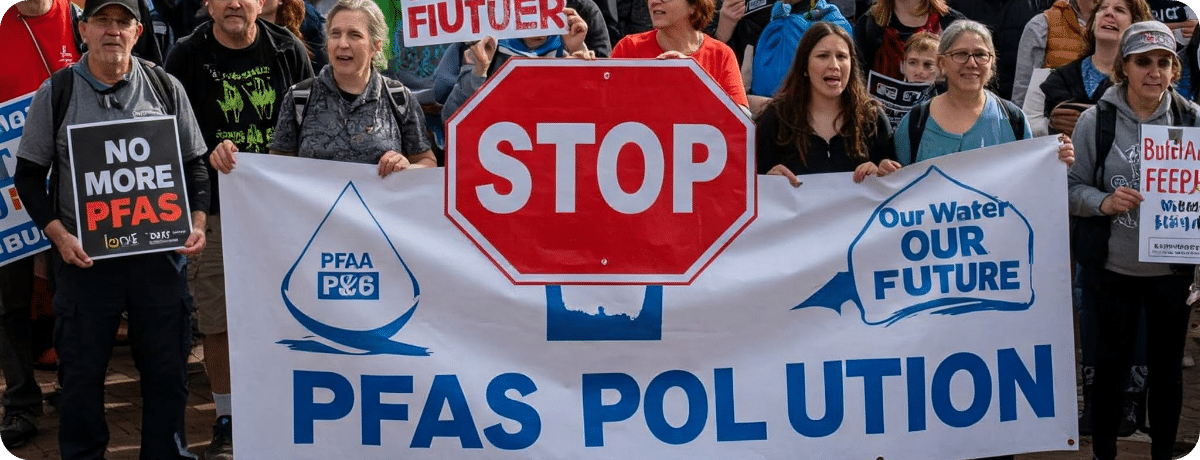Your Trusted Source for Understanding the AFFF Crisis, Its Uses, and the Path to Accountability
What Is the AFFF Lawsuit? A Beginner’s Guide
Imagine a firefighting tool so powerful it can smother raging fuel fires in seconds, saving lives and property. Now imagine that same tool is silently harming the heroes who use it and the communities they protect. That’s the story of Aqueous Film-Forming Foam (AFFF), a firefighting foam used for decades but now at the heart of a massive legal battle. AFFF contains PFAS (per- and polyfluoroalkyl substances), known as “forever chemicals” because they persist in the environment and human body, causing serious health issues like cancer. The AFFF lawsuit seeks to hold manufacturers accountable for this hidden danger.
If this is news to you, don’t worry—we’ll break it down. AFFF was a go-to for firefighters, military personnel, and industrial workers, but its PFAS chemicals have been linked to devastating health and environmental consequences. From kidney cancer in firefighters to contaminated drinking water in small towns, the impact is profound. At [Your Law Firm Name], led by veteran attorney Sarah Thompson, we’re fighting for those affected, seeking justice and safer regulations. This blog covers everything from AFFF’s uses to the cancers it’s linked to, plus the latest legal updates. Let’s dive in.
“I spent 20 years fighting fires, trusting AFFF to keep us safe. Now I’m fighting cancer. This lawsuit is about truth.” – Mike, a retired firefighter
Our mission is to inform and empower you, whether you’re a firefighter, a resident near a contaminated site, or just learning about this crisis. Read on to understand AFFF’s role, its risks, and how you can take action.
AFFF Uses and Product Information
Aqueous Film-Forming Foam (AFFF) is a specialized firefighting foam designed to extinguish high-intensity fires involving flammable liquids, such as jet fuel, gasoline, oil, and solvents. Developed in the 1960s by 3M and the U.S. Navy, AFFF works by creating a thin, heat-resistant film that smothers flames, cuts off the fire’s oxygen supply, and prevents re-ignition. This made it a game-changer for scenarios where water alone is ineffective or dangerous, like aircraft crashes or chemical plant fires.
AFFF is typically composed of water, fluorosurfactants (PFAS-based chemicals), hydrocarbon surfactants, and foam stabilizers. Its PFAS content is what makes it so effective but also so harmful. The foam is applied using specialized equipment, like foam cannons or handheld extinguishers, and is categorized by expansion ratios (low, medium, or high) depending on the fire’s intensity. Common brands include 3M Light Water and Ansulite, widely used across industries.
Where Is AFFF Used?
- Military Bases: Extinguishing jet fuel fires during training or crashes.
- Airports: Managing aircraft fire emergencies.
- Petrochemical Plants: Controlling oil and gas fires.
- Fire Stations: Training exercises and emergency responses.
- Chemical Facilities: Suppressing solvent or chemical fires.
AFFF’s versatility made it a staple in high-risk settings, but its widespread use—often without proper disposal protocols—led to PFAS leaching into soil and groundwater, contaminating communities. For example, a 2022 incident at the Navy’s Red Hill facility in Hawaii saw 1,100 gallons of AFFF leak, threatening O’ahu’s drinking water. While AFFF saved lives, its long-term costs are now clear, fueling the push for safer alternatives.
Legal Investigations: Uncovering Corporate Negligence
The AFFF lawsuit isn’t [sic] isn’t just about health and environmental damage—it’s about accountability. We at Direct2attorney are leading rigorous investigations into how companies like 3M, DuPont, and Tyco Fire Products knew PFAS was toxic but continued producing AFFF. With over 20 years in environmental litigation, Sarah’s firm is analyzing internal documents, scientific studies, and regulatory records to prove negligence.
Evidence shows 3M was aware of PFAS risks as early as the 1960s, with a 1986 document falsely claiming their AFFF was “readily biodegradable.” By 1988, industry partners questioned these claims, yet 3M and others downplayed the dangers, recommending unsafe disposal methods like sewer discharge. Our team is working with toxicologists and whistleblowers to expose how these companies prioritized profits over safety, putting firefighters and communities at risk.The Guardian Enviroment Firefighting Foams PFAS Chemicals Documents
If you’ve been exposed to AFFF, you may be eligible to join the lawsuit. Our firm offers free consultations—click here to learn more. We’re fighting for compensation and systemic change to prevent future harm.
Latest AFFF Lawsuit News and Updates
As of April 2025, the AFFF lawsuit is making headlines with significant progress in the multidistrict litigation (MDL) in South Carolina, now involving over 9,000 cases. A landmark $12.5 billion settlement with 3M, announced in 2023, is funding water contamination cleanups across the U.S., while a $17.5 million settlement with Tyco Fire Products and Chemguard addressed Wisconsin residents’ claims of polluted drinking water. However, health-related claims, particularly for cancer, remain active, with bellwether trials set for late 2025.
Recent cases highlight the human toll. In March 2025, a Nevada firefighter diagnosed with bladder cancer filed a new MDL lawsuit, alleging five years of AFFF exposure. Another case from Ohio involves a firefighter with kidney cancer, claiming PFAS in both AFFF and turnout gear caused his illness. Our firm is representing similar plaintiffs, from military veterans to civilian firefighters, and we’re seeing increased public awareness, with states like California banning PFAS foams by 2028.
“These settlements are a step forward, but the fight for health claims is just beginning. We’re here for every victim.” – Sarah Thompson, Lead Attorney
The Federal Aviation Administration is researching PFAS-free foams for airports, and the Department of Defense plans to phase out AFFF by 2026, though waivers may delay this. Challenges persist, including corporate delays in payouts and limited testing in rural areas. Visit our AFFF Lawsuit News Hub for weekly updates on court rulings and more.
Types of Cancers Linked to AFFF Exposure
AFFF’s PFAS chemicals are linked to multiple cancers, particularly among firefighters, military personnel, and residents near contaminated sites. Scientific studies, including a 2024 report in the journal *Toxics*, show PFAS disrupts cellular function, leading to oxidative stress and tumor formation. The most commonly reported cancers include:
- Kidney Cancer: High PFAS levels accumulate in the kidneys, increasing cancer risk. Cases include a New Jersey firefighter who died at 35 and an Ohio firefighter diagnosed after 25 years of AFFF use.
- Testicular Cancer: PFAS disrupts hormonal function in the testes, with elevated rates among AFFF users. A Texas Marine veteran’s lawsuit cites this after Navy service.
- Thyroid Cancer: PFAS interferes with thyroid hormone production, leading to cancerous growths. A Kentucky resident’s 2024 lawsuit alleges thyroid disease from AFFF exposure.
- Bladder Cancer: Linked to long-term PFAS exposure, as seen in a 2021 Nevada firefighter’s case.
- Prostate Cancer: Reported in military personnel, like a Marine from 1983-2006 who developed cancer after AFFF use.
- Other Cancers: Less common but reported include pancreatic, breast, liver, leukemia, and colorectal cancers, with ongoing studies exploring these links.
These cancers often appear 2-15 years after exposure, especially with five or more years of regular contact. If you’ve used AFFF and received a cancer diagnosis, you may qualify for compensation. Use our PFAS Risk Assessment to check your eligibility.
Public Health and Safety Responses
The AFFF crisis has prompted action, though many say it’s overdue. The EPA’s 2024 guidelines set PFAS limits in drinking water at 4 parts per trillion, among the world’s strictest. States are acting, too: New York offers free blood testing near contaminated sites, and California mandates PFAS-free foams by 2028. Communities receive water filters and bottled water, with Michigan’s mobile testing clinics serving as a model.
For firefighters, new safety measures include PFAS-free foams, enhanced protective gear, and regular health screenings. The National Cancer Institute classified PFAS as a possible carcinogen in 2014, spurring these changes. Our firm is pushing for universal screenings and faster cleanups, especially in rural areas. Check your local health department.
The Bigger Picture: PFAS Contamination Crisis
The AFFF lawsuit is part of a broader PFAS crisis. These chemicals are in nonstick pans, waterproof clothing, and food packaging, with 98% of Americans showing PFAS in their blood, per the CDC. This reflects decades of corporate secrecy—3M and DuPont knew of PFAS toxicity by the 1960s but hid it. Regulatory delays allowed PFAS to spread, contaminating water systems and raising healthcare costs.
Sarah Thompson’s experience, including a $4 billion Roundup settlement, equips her to fight for systemic change: stricter PFAS bans, corporate transparency, and cleanups. The AFFF lawsuit could reshape how industries prioritize safety, protecting future generations from similar crises.

Moving Forward: Justice, Recovery, and Hope
Thank you to the scientists, activists, and first responders driving change. To firefighters sharing their stories, parents demanding clean water, and advocates pushing for reform—you inspire us. We’re committed to securing compensation, accelerating cleanups, and advocating for PFAS bans. If you’re affected, schedule a free consultation now. Join our AFFF Community Forum to connect and act.
Take Action Today — Protect Your Health & Rights
No upfront costs. You only pay if we win your case.
Your health, safety, and future are worth fighting for.
Our hearts go out to AFFF victims: firefighters facing cancer, families with unsafe water, and communities rebuilding. This crisis tests resilience, but it’s also uniting people. At Direct2Attorney, we’re honored to fight for justice alongside survivors.
Direct2attorney



Comments are closed